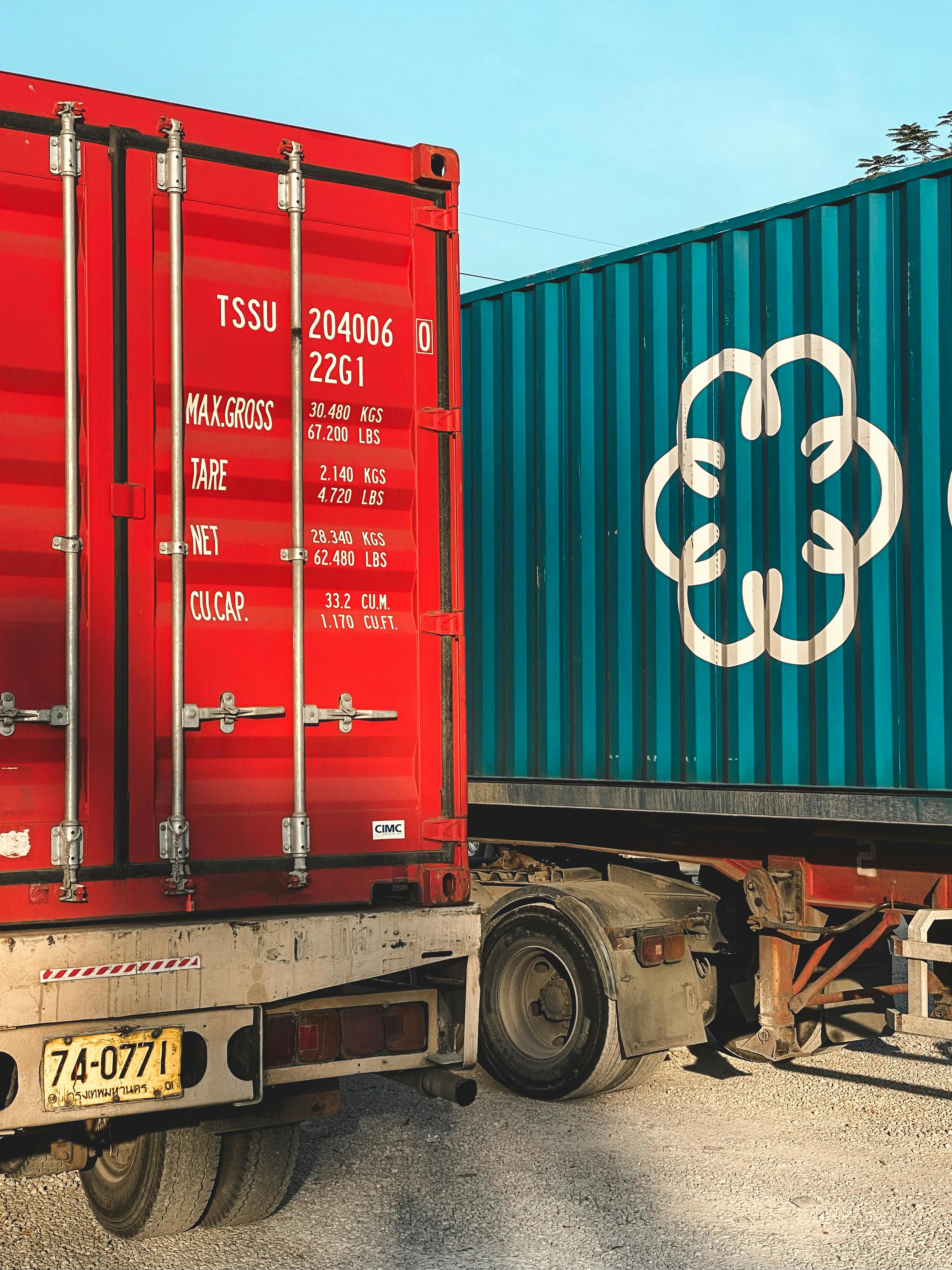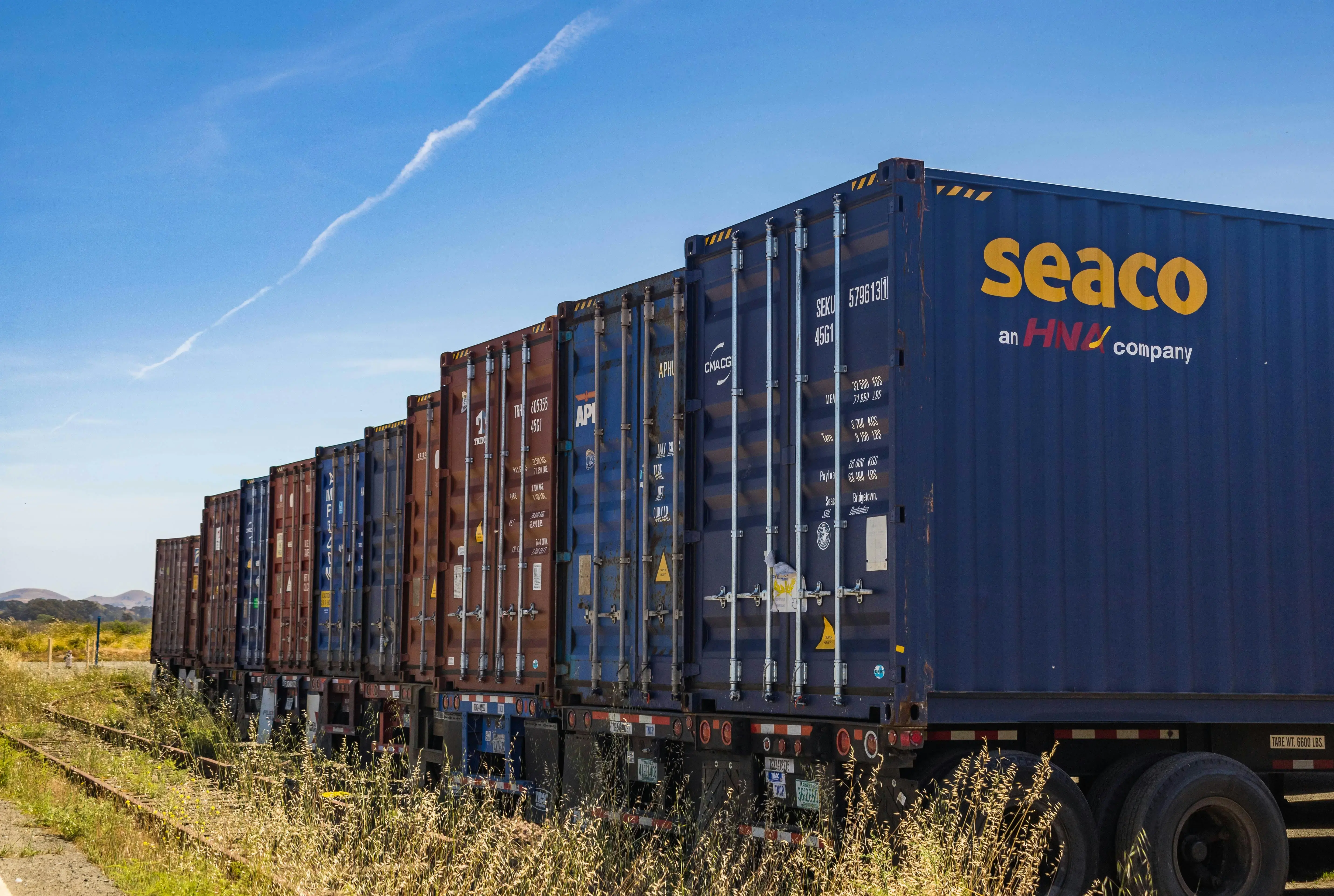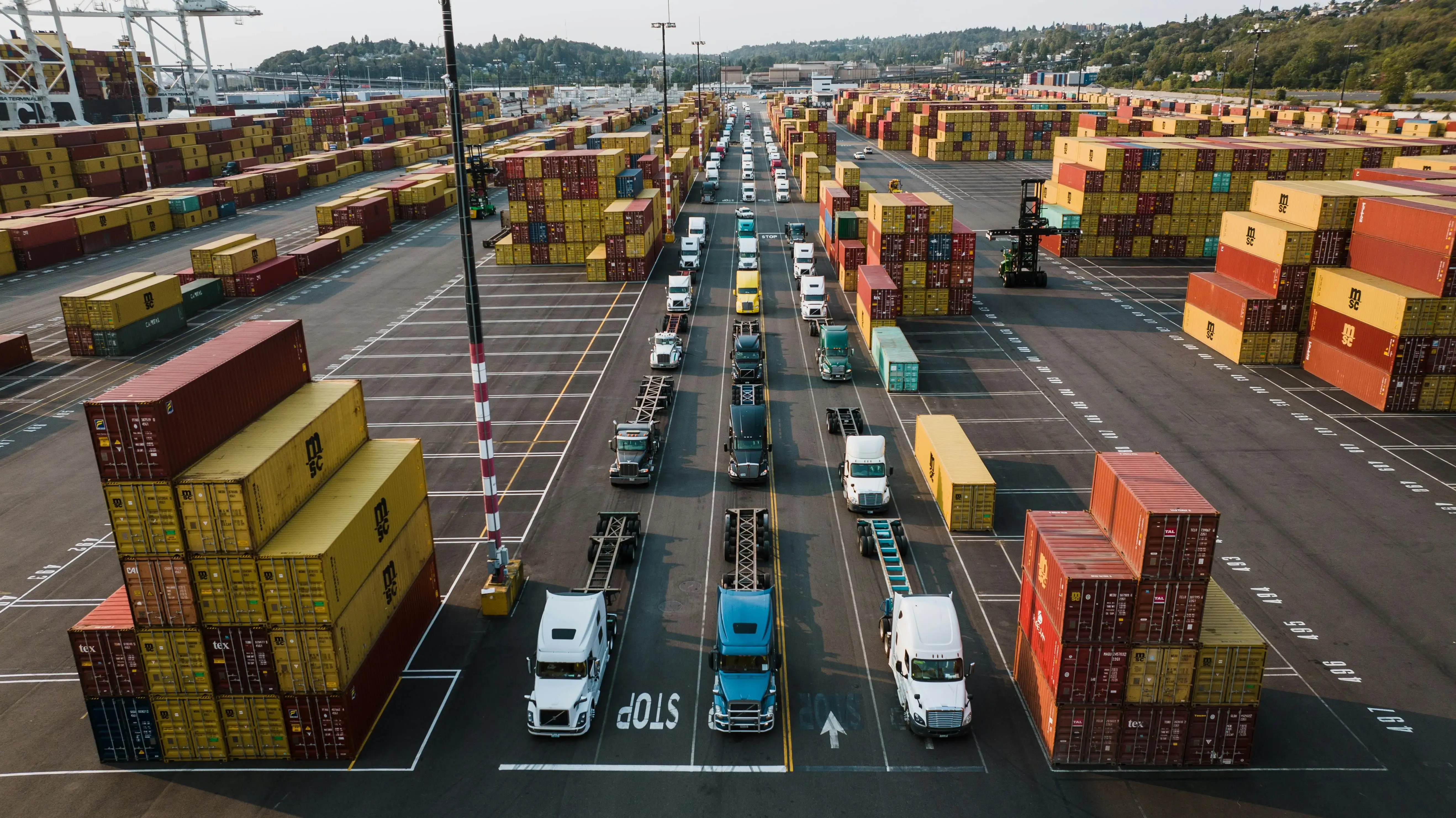Drayage vs. OTR Trucking: Container Drayage, Intermodal & Freight Logistics
In the complex world of freight shipping and global logistics, understanding the differences between drayage and over-the-road (OTR) trucking is essential for optimizing your supply chain operations. While both involve moving goods by truck, these transportation methods serve distinct purposes in the logistics industry, with drayage focusing on short-distance transport and OTR handling long-haul freight movement. This comprehensive guide explores the fundamental differences between these critical components of the logistics industry, helping businesses make informed decisions about their freight transportation needs and understand how drayage plays a critical role in connecting different modes of transportation.
What is Drayage and Why is it Important in the Supply Chain?
Drayage refers to the specialized transportation of goods over short distances, typically within a single metropolitan area or within 50-100 miles of ports, rail terminals, and distribution centers. This essential component of the logistics industry serves as the critical link between different modes of transportation, ensuring smooth cargo movement from ships to trucks, trucks to rail, and rail to warehouses. The term originates from "dray," a horse-drawn cart used centuries ago to move heavy loads over short distances.
Drayage is a vital part of intermodal shipping, facilitating the seamless transfer of shipping containers between various transport modes. Modern drayage operations involve specialized trucks equipped with chassis designed specifically for handling standardized shipping containers, making it an indispensable service in port logistics and freight transportation. The drayage service market has grown significantly, with North America seeing over 60 million drayage movements yearly and a market size exceeding $50 billion.
Think of drayage as the "first mile" or "last mile" of the shipping process, connecting global freight networks with local distribution centers and warehouses. Without efficient drayage services, ports would become congested, containers would sit idle, and the entire supply chain would experience costly delays and bottlenecks.
What is Over-the-Road (OTR) Trucking and How Does it Differ?
Over-the-road trucking involves long-distance freight transportation, typically covering hundreds or thousands of miles across state lines and even international borders. Unlike drayage, which operates within localized areas, OTR trucking refers to the movement of goods across vast distances using highways and major transportation routes. OTR drivers often spend extended periods on the road, sometimes weeks at a time, covering cross-country routes to deliver cargo from manufacturers to retailers or distribution centers.
The key differences between drayage and OTR trucking extend beyond simple distance considerations. While drayage trucks are designed for frequent starts and stops within urban environments and port facilities, OTR trucks are optimized for highway efficiency and long-haul performance. OTR trucking offers economies of scale for bulk freight movement over long distances, making it the preferred choice for transporting large volumes of goods between major markets.
OTR operations focus on maximizing fuel efficiency and travel time across highways, connecting manufacturers with distribution centers or moving goods between different regions. This mode of transportation plays a crucial role in domestic commerce, enabling businesses to reach customers across vast geographic areas while maintaining cost-effective freight logistics.
Key Differences Between Drayage and OTR Trucking: Distance, Equipment, and Operations
Understanding the differences between drayage and over-the-road trucking requires examining several critical factors that distinguish these transportation methods. The most obvious difference lies in distance and operational scope, with drayage typically covering short distances under 50-100 miles while OTR trucking involves long-haul movements spanning hundreds or thousands of miles. This fundamental distinction impacts everything from equipment design to driver requirements and operational strategies.
Equipment differences between drayage and OTR operations reflect their specialized purposes. Drayage trucks often feature day cab designs without sleeper compartments, making them lighter and more fuel-efficient for frequent short trips between ports and nearby facilities. These vehicles are equipped with specialized chassis designed to handle various container types, including standard dry containers, refrigerated units, and oversized cargo. In contrast, OTR trucks typically feature larger cabs with sleeper compartments and are designed for maximum highway efficiency and driver comfort during extended journeys.
Operational focus also differs significantly between these transportation modes. Drayage operations emphasize quick turnaround times, efficient container handling, and navigating complex port or intermodal terminal environments. OTR trucking prioritizes maximizing distance coverage, fuel efficiency, and on-time delivery across long routes. These operational differences require distinct skill sets, with drayage drivers needing expertise in port logistics and container handling, while OTR drivers focus on long-distance route planning and highway safety.
Types of Drayage Services in Container Transportation
The drayage industry encompasses various specialized services designed to meet specific supply chain needs. According to the Intermodal Association of North America, there are six primary types of drayage services, each serving distinct functions in the freight transportation process. Port drayage, also known as pier drayage, involves moving containers from seaports to nearby warehouses, distribution centers, or rail terminals within the same metropolitan area.
Inter-carrier drayage handles the transfer of containers between different transportation carriers at various hubs, facilitating seamless transitions when goods need to shift from one carrier's network to another. Intra-carrier drayage manages container movement within a single carrier's network, such as transporting freight from a rail terminal to a warehouse operated by the same company. Expedited drayage provides time-sensitive transportation for perishable goods or high-priority cargo that requires immediate delivery.
Additional drayage services include shuttle drayage, which moves containers to temporary storage when port or rail facilities reach capacity, and door-to-door drayage, which delivers goods directly to end customers. Long-haul drayage, while less common, involves transporting containers over greater distances than typical drayage operations, sometimes covering several hundred miles to reach inland distribution centers. Each type of drayage service requires specialized equipment, routing expertise, and operational procedures to ensure efficient cargo movement within the broader intermodal transportation network.
How Does Drayage Work Within Intermodal Transportation Networks?
Drayage serves as the critical connecting link within intermodal transportation systems, enabling seamless cargo flow between ships, trains, and trucks. In a typical intermodal journey, a container might arrive at a port via ocean vessel, be transported by drayage truck to a nearby rail terminal, travel cross-country by train, and then complete its journey via another drayage move to the final destination. This integration allows shippers to leverage the cost advantages of different transportation modes while maintaining cargo security and reducing handling requirements.
The intermodal drayage process typically begins when shipping containers are unloaded from vessels at marine terminals and need transportation to rail facilities or local distribution centers. Drayage trucks equipped with specialized chassis collect these containers and transport them short distances to connect with rail networks or deliver them to nearby warehouses. This process reverses for export cargo, with drayage services collecting containers from inland facilities and delivering them to ports for ocean transport.
Efficient drayage operations are essential for maintaining the speed and reliability of intermodal transportation. Delays in drayage can create bottlenecks that affect entire supply chains, leading to port congestion, missed rail connections, and increased logistics costs. Modern drayage companies use advanced technology including GPS tracking, real-time monitoring, and predictive analytics to optimize routes and minimize delays within intermodal networks. This technological integration ensures that drayage maintains its vital role in the supply chain by providing reliable, efficient connections between different modes of transportation.
What Are the Cost Factors and Pricing Models for Drayage Services?
Drayage costs depend on multiple factors that reflect the specialized nature of this transportation service. Distance remains a primary cost driver, with most drayage operations charging based on mileage within their service area. However, unlike long-haul trucking, drayage pricing often includes additional fees for specialized equipment, port access, and waiting times at terminals. Container type and size significantly impact pricing, with refrigerated containers, oversized cargo, and hazardous materials requiring specialized handling and higher rates.
Equipment requirements play a crucial role in drayage rate calculations, as different container types require specific chassis configurations. Standard chassis handle most dry containers, while tri-axle chassis are necessary for overweight loads, and extendable chassis accommodate longer containers. Gooseneck chassis serve low-clearance containers, and each specialized equipment type commands different pricing levels. Port fees, terminal charges, and accessorial services such as detention time, chassis splits, and expedited delivery also contribute to overall drayage costs.
The drayage rate structure typically includes base transportation charges plus various accessorial fees that can significantly impact total costs. Detention charges apply when trucks wait beyond free time limits at ports or delivery locations, while demurrage fees accumulate when containers remain at terminals longer than allowed. Chassis rental fees, fuel surcharges, and specialized handling charges for hazardous materials or temperature-controlled cargo add to the complexity of drayage pricing. Understanding these cost components helps shippers budget effectively and select drayage carriers that offer transparent pricing and efficient service.
Container Drayage vs General Freight Trucking: Specialized Requirements
Container drayage differs significantly from general freight trucking in terms of equipment, regulations, and operational requirements. While general freight trucking involves transporting various types of goods using standard trailers, container drayage specifically handles standardized shipping containers using specialized chassis and trucks designed for intermodal operations. This specialization requires drayage carriers to maintain different equipment types and meet specific certification requirements for port access and container handling.
Regulatory compliance presents another key distinction between container drayage and general freight operations. Drayage truckers often need special certifications to operate within port areas, including TWIC (Transportation Worker Identification Credential) cards for port security access and specialized training for handling maritime containers. Insurance requirements for drayage operations typically exceed those for general freight due to the higher risks associated with port environments and valuable international cargo.
The operational environment also sets container drayage apart from general freight trucking. Drayage operations require navigating complex port facilities, understanding terminal procedures, and coordinating with multiple stakeholders including shipping lines, port authorities, and customs officials. General freight trucking, while regulated, operates in a more straightforward environment focused on point-to-point delivery without the specialized requirements of maritime and intermodal facilities. These differences make container drayage a distinct segment within the broader trucking industry, requiring specialized knowledge, equipment, and operational expertise.
Why is Understanding Drayage Important for Logistics Professionals?
Understanding drayage is crucial for logistics professionals because it represents one of the most complex and costly segments of the supply chain. Poor drayage planning can lead to significant delays, increased costs, and supply chain disruptions that impact customer satisfaction and business profitability. With the growth of global trade and e-commerce, efficient drayage has become increasingly important for maintaining competitive advantage in logistics operations.
The drayage segment often presents the highest risk of delays and cost overruns within intermodal transportation. Port congestion, equipment shortages, and regulatory compliance issues can quickly escalate drayage costs and create supply chain bottlenecks. Logistics professionals who understand drayage operations can better anticipate these challenges, develop contingency plans, and select reliable drayage carriers that minimize risks and optimize performance.
Knowledge of drayage also enables better integration with broader logistics strategies, including inventory management, warehouse operations, and customer delivery commitments. As sustainability becomes increasingly important in logistics operations, understanding drayage allows professionals to leverage eco-friendly transportation options and optimize routing to reduce environmental impact. This comprehensive understanding of drayage supports more effective decision-making and strategic planning in today's complex global logistics environment.
The Role of Technology in Modern Drayage Operations
Technology plays an increasingly vital role in modernizing drayage operations and addressing traditional challenges in this segment of the logistics industry. GPS tracking systems provide real-time visibility into container movements, allowing shippers and consignees to monitor progress and anticipate arrival times. This visibility helps reduce uncertainty and enables better coordination with warehouse operations and downstream logistics activities.
Advanced routing and optimization software helps drayage companies minimize empty miles, reduce fuel consumption, and improve asset utilization. Predictive analytics enable better capacity planning and help carriers anticipate demand fluctuations, while electronic documentation systems streamline paperwork and reduce processing delays at ports and terminals. These technological advances are transforming drayage from a traditionally manual, phone-based operation into a more efficient, data-driven service.
Digital platforms and mobile applications are improving communication between drayage carriers, shippers, and port facilities. Automated appointment scheduling systems reduce wait times at terminals, while electronic payment processing speeds up transactions and improves cash flow for carriers. As the drayage industry continues to evolve, technology adoption will be essential for companies seeking to remain competitive and meet growing customer expectations for transparency, reliability, and efficiency in freight transportation.
Environmental Considerations in Drayage vs OTR Transportation
Environmental impact considerations highlight important differences between drayage and OTR transportation methods. Drayage operations, typically involving frequent stops and starts in urban environments, have traditionally relied on diesel trucks that contribute to local air pollution and emissions. However, the industry is experiencing a shift toward cleaner technologies, with many drayage companies adopting electric and hybrid vehicles for short-haul container transportation.
The environmental benefits of efficient drayage extend beyond individual vehicle emissions to include broader supply chain optimization. By facilitating smooth intermodal connections, drayage enables greater use of rail transportation for long-haul freight movement, which produces significantly lower emissions per ton-mile compared to long-haul trucking. This integration supports overall reductions in transportation-related carbon emissions across supply chains.
Regulatory changes are driving environmental improvements in both drayage and OTR operations. Emissions standards, low-emission zones around ports, and sustainability mandates are encouraging adoption of cleaner technologies and more efficient operational practices. Companies that proactively address environmental considerations in their transportation strategies position themselves advantageously for future regulatory requirements and customer demands for sustainable logistics solutions.
Summary: Key Points to Remember About Drayage vs OTR Trucking
-
Distance and Scope: Drayage covers short distances (typically under 50-100 miles) within metropolitan areas, while OTR trucking handles long-haul transportation across hundreds or thousands of miles
-
Equipment Differences: Drayage trucks use specialized chassis for container handling and typically feature day cab designs, while OTR trucks have sleeper cabs and standard trailers optimized for highway efficiency
-
Operational Focus: Drayage emphasizes quick turnaround times and intermodal connections, while OTR focuses on maximizing distance coverage and fuel efficiency
-
Supply Chain Role: Drayage serves as the critical link between different transportation modes (ships, trains, trucks), while OTR provides direct long-distance freight movement
-
Service Types: Drayage includes port, inter-carrier, intra-carrier, expedited, shuttle, and door-to-door services, each serving specific intermodal transportation needs
-
Cost Structure: Drayage pricing includes specialized equipment fees, port charges, and accessorial services, while OTR pricing focuses on mileage and fuel efficiency
-
Regulatory Requirements: Drayage operations require special certifications for port access and container handling, while OTR follows standard trucking regulations
-
Technology Integration: Modern drayage operations rely heavily on GPS tracking, route optimization, and digital platforms to manage complex intermodal logistics
-
Environmental Impact: Both sectors are adopting cleaner technologies, with drayage enabling broader supply chain sustainability through efficient intermodal connections
-
Industry Importance: Understanding both drayage and OTR is essential for optimizing logistics strategies and managing the complexities of modern freight transportation
Get Your Instant Drayage Quote Today
Miami Container Trucking offers instant, transparent pricing through our online drayage calculator. As a South Florida-based, asset-based carrier, we provide:
-
Instant rate calculations for Port of Miami and Port Everglades
-
Local expertise with decades of experience navigating South Florida ports
-
Asset-based reliability with our own trucks, chassis, and TWIC-certified drivers
-
Integrated services including warehousing and transloading
-
Real-time GPS tracking for complete shipment visibility
-
Transparent pricing with no hidden fees or surprises
Whether you need to move dry containers, reefers, overweight cargo, or hazardous materials, our experienced team understands the unique challenges of container drayage in Miami and South Florida.
Get your instant quote today and discover why businesses throughout South Florida trust Miami Container Trucking for their drayage needs.
You May Also Like
These Related Stories

Calculating Drayage Rates in Miami: Costs & Key Factors

Miami Container Drayage Companies & Service


